Social Media Ethics and Privacy Concerns: A Detailed Report
VerifiedAdded on 2022/08/28
|40
|9040
|20
Report
AI Summary
This report delves into the intricate relationship between social media and individual privacy. It begins with an introduction to the concept of social media, exploring its evolution and impact on communication. The literature review covers social media concepts, types of privacy violations, associated risks and threats, and mitigation strategies. The research methodology details the research philosophy, approach (including a Google survey), design, and data collection methods. The data analysis chapter presents findings based on survey responses, examining how companies utilize user data. The report concludes with a summary of findings, along with recommendations to protect sensitive information and navigate the challenges of maintaining privacy in the digital age. The report also focuses on ethical considerations, challenges, and potential solutions for OSN users.

Running head: SOCIAL MEDIA ETHICS
SOCIAL MEDIA AND OTHER PEOPLE'S PRIVACY
Name of the Student:
Name of the University:
Author Note:
SOCIAL MEDIA AND OTHER PEOPLE'S PRIVACY
Name of the Student:
Name of the University:
Author Note:
Paraphrase This Document
Need a fresh take? Get an instant paraphrase of this document with our AI Paraphraser
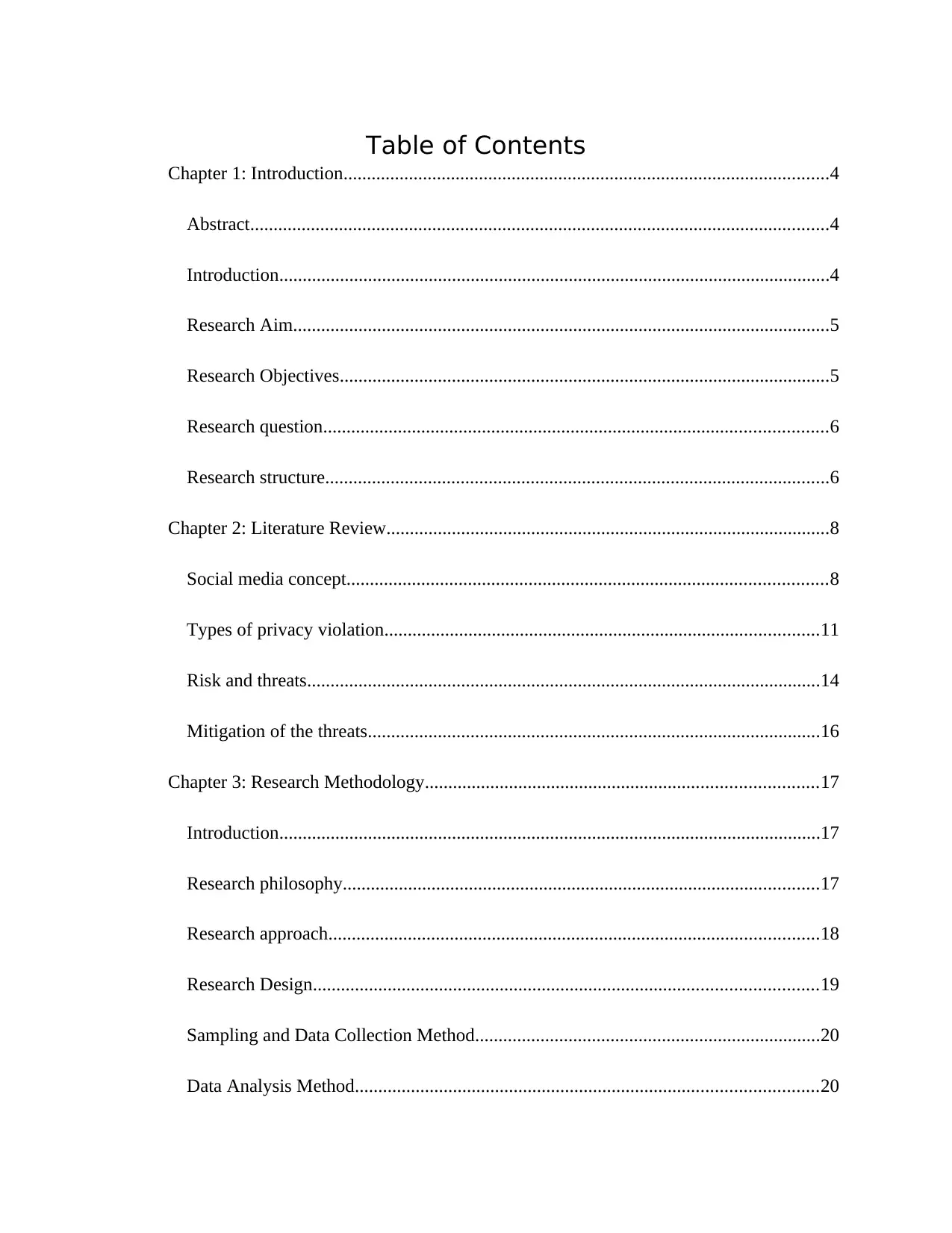
Table of Contents
Chapter 1: Introduction........................................................................................................4
Abstract............................................................................................................................4
Introduction......................................................................................................................4
Research Aim...................................................................................................................5
Research Objectives.........................................................................................................5
Research question............................................................................................................6
Research structure............................................................................................................6
Chapter 2: Literature Review...............................................................................................8
Social media concept.......................................................................................................8
Types of privacy violation.............................................................................................11
Risk and threats..............................................................................................................14
Mitigation of the threats.................................................................................................16
Chapter 3: Research Methodology....................................................................................17
Introduction....................................................................................................................17
Research philosophy......................................................................................................17
Research approach.........................................................................................................18
Research Design............................................................................................................19
Sampling and Data Collection Method..........................................................................20
Data Analysis Method...................................................................................................20
Chapter 1: Introduction........................................................................................................4
Abstract............................................................................................................................4
Introduction......................................................................................................................4
Research Aim...................................................................................................................5
Research Objectives.........................................................................................................5
Research question............................................................................................................6
Research structure............................................................................................................6
Chapter 2: Literature Review...............................................................................................8
Social media concept.......................................................................................................8
Types of privacy violation.............................................................................................11
Risk and threats..............................................................................................................14
Mitigation of the threats.................................................................................................16
Chapter 3: Research Methodology....................................................................................17
Introduction....................................................................................................................17
Research philosophy......................................................................................................17
Research approach.........................................................................................................18
Research Design............................................................................................................19
Sampling and Data Collection Method..........................................................................20
Data Analysis Method...................................................................................................20

Research Ethical Considerations...................................................................................20
Research Limitations.....................................................................................................21
Chapter 4: Data Analysis...................................................................................................21
Chapter 5: Conclusion and Recommendations..................................................................32
Conclusion.....................................................................................................................32
Recommendations..........................................................................................................32
References..........................................................................................................................33
Research Limitations.....................................................................................................21
Chapter 4: Data Analysis...................................................................................................21
Chapter 5: Conclusion and Recommendations..................................................................32
Conclusion.....................................................................................................................32
Recommendations..........................................................................................................32
References..........................................................................................................................33
⊘ This is a preview!⊘
Do you want full access?
Subscribe today to unlock all pages.

Trusted by 1+ million students worldwide
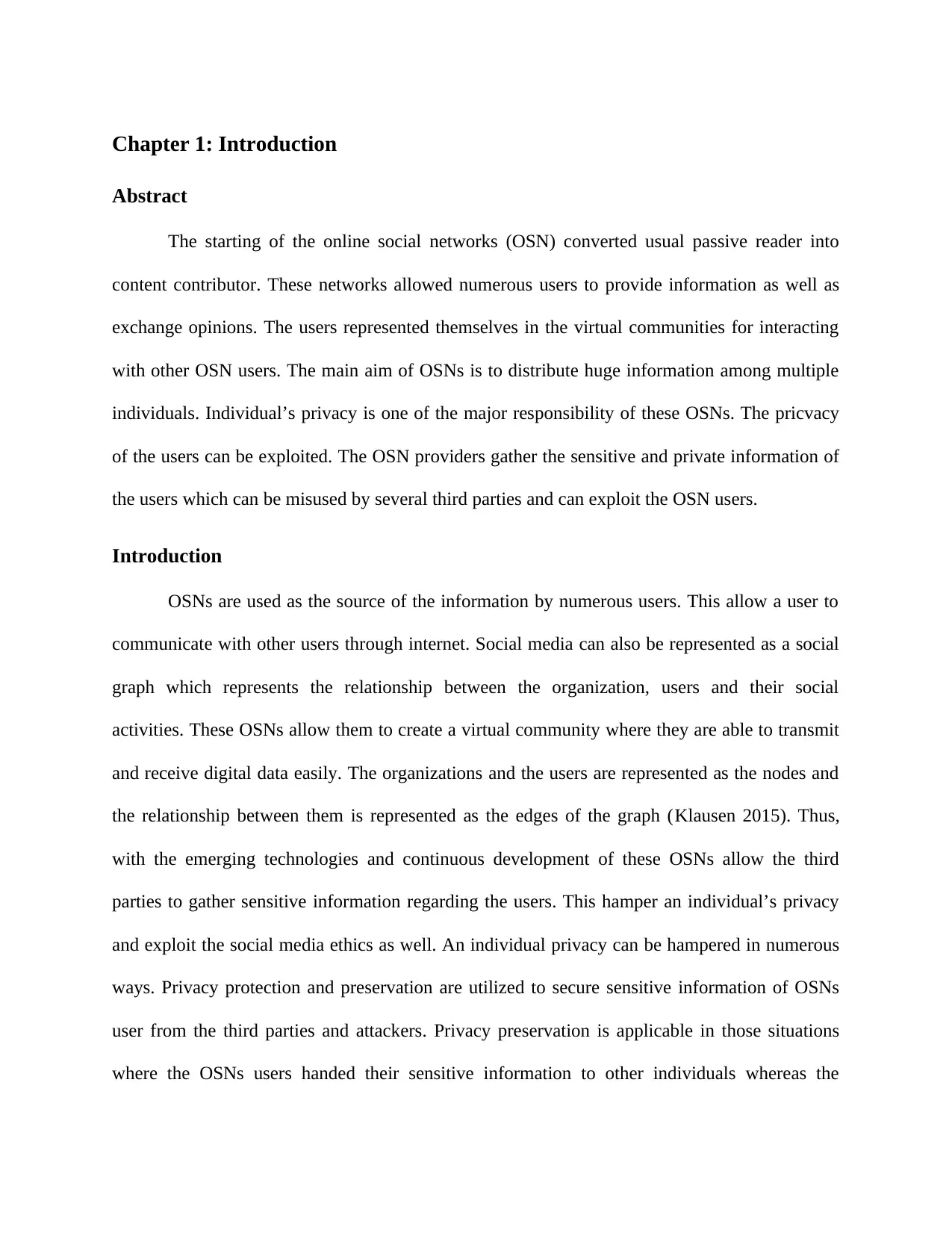
Chapter 1: Introduction
Abstract
The starting of the online social networks (OSN) converted usual passive reader into
content contributor. These networks allowed numerous users to provide information as well as
exchange opinions. The users represented themselves in the virtual communities for interacting
with other OSN users. The main aim of OSNs is to distribute huge information among multiple
individuals. Individual’s privacy is one of the major responsibility of these OSNs. The pricvacy
of the users can be exploited. The OSN providers gather the sensitive and private information of
the users which can be misused by several third parties and can exploit the OSN users.
Introduction
OSNs are used as the source of the information by numerous users. This allow a user to
communicate with other users through internet. Social media can also be represented as a social
graph which represents the relationship between the organization, users and their social
activities. These OSNs allow them to create a virtual community where they are able to transmit
and receive digital data easily. The organizations and the users are represented as the nodes and
the relationship between them is represented as the edges of the graph (Klausen 2015). Thus,
with the emerging technologies and continuous development of these OSNs allow the third
parties to gather sensitive information regarding the users. This hamper an individual’s privacy
and exploit the social media ethics as well. An individual privacy can be hampered in numerous
ways. Privacy protection and preservation are utilized to secure sensitive information of OSNs
user from the third parties and attackers. Privacy preservation is applicable in those situations
where the OSNs users handed their sensitive information to other individuals whereas the
Abstract
The starting of the online social networks (OSN) converted usual passive reader into
content contributor. These networks allowed numerous users to provide information as well as
exchange opinions. The users represented themselves in the virtual communities for interacting
with other OSN users. The main aim of OSNs is to distribute huge information among multiple
individuals. Individual’s privacy is one of the major responsibility of these OSNs. The pricvacy
of the users can be exploited. The OSN providers gather the sensitive and private information of
the users which can be misused by several third parties and can exploit the OSN users.
Introduction
OSNs are used as the source of the information by numerous users. This allow a user to
communicate with other users through internet. Social media can also be represented as a social
graph which represents the relationship between the organization, users and their social
activities. These OSNs allow them to create a virtual community where they are able to transmit
and receive digital data easily. The organizations and the users are represented as the nodes and
the relationship between them is represented as the edges of the graph (Klausen 2015). Thus,
with the emerging technologies and continuous development of these OSNs allow the third
parties to gather sensitive information regarding the users. This hamper an individual’s privacy
and exploit the social media ethics as well. An individual privacy can be hampered in numerous
ways. Privacy protection and preservation are utilized to secure sensitive information of OSNs
user from the third parties and attackers. Privacy preservation is applicable in those situations
where the OSNs users handed their sensitive information to other individuals whereas the
Paraphrase This Document
Need a fresh take? Get an instant paraphrase of this document with our AI Paraphraser
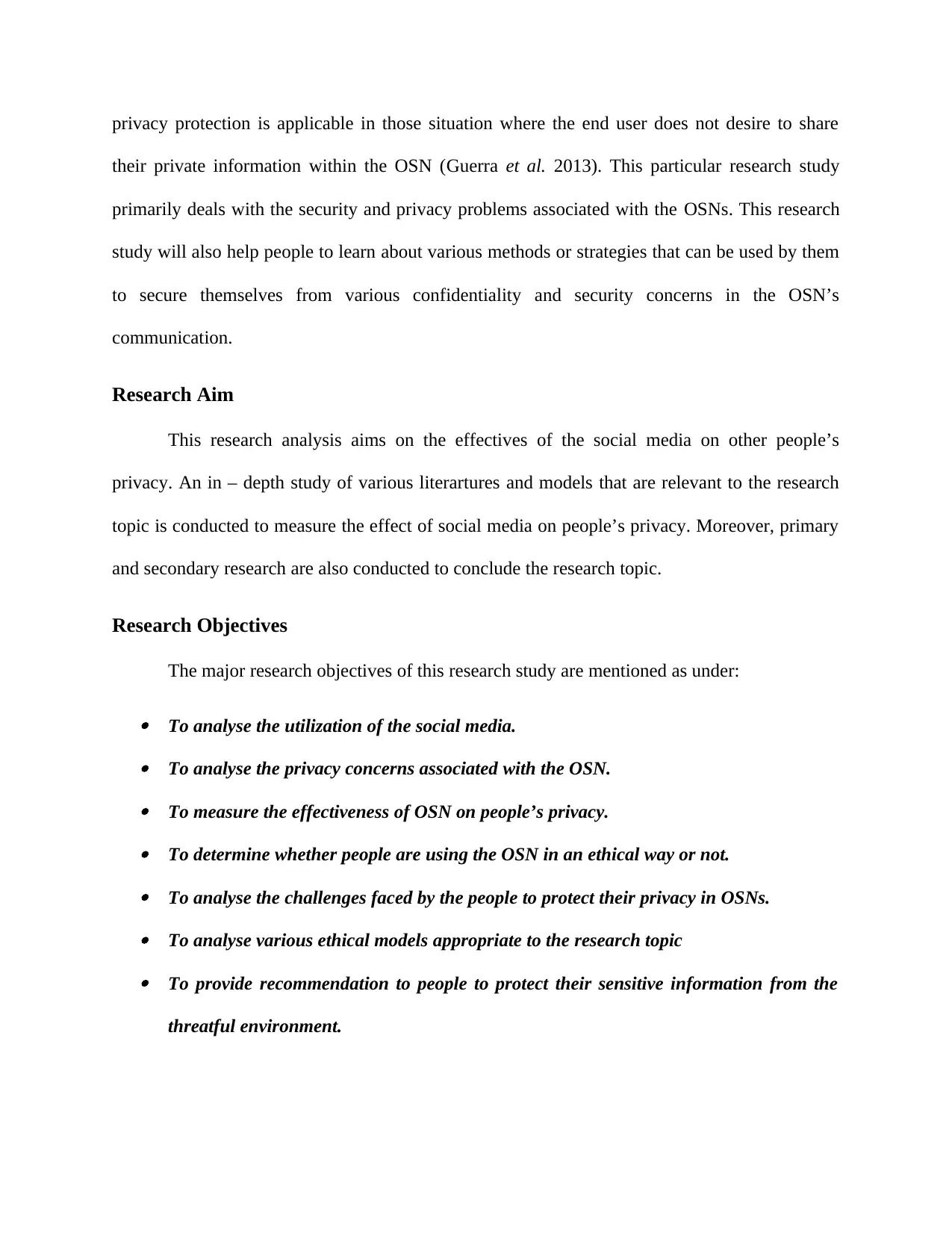
privacy protection is applicable in those situation where the end user does not desire to share
their private information within the OSN (Guerra et al. 2013). This particular research study
primarily deals with the security and privacy problems associated with the OSNs. This research
study will also help people to learn about various methods or strategies that can be used by them
to secure themselves from various confidentiality and security concerns in the OSN’s
communication.
Research Aim
This research analysis aims on the effectives of the social media on other people’s
privacy. An in – depth study of various literartures and models that are relevant to the research
topic is conducted to measure the effect of social media on people’s privacy. Moreover, primary
and secondary research are also conducted to conclude the research topic.
Research Objectives
The major research objectives of this research study are mentioned as under:
To analyse the utilization of the social media. To analyse the privacy concerns associated with the OSN. To measure the effectiveness of OSN on people’s privacy. To determine whether people are using the OSN in an ethical way or not. To analyse the challenges faced by the people to protect their privacy in OSNs. To analyse various ethical models appropriate to the research topic To provide recommendation to people to protect their sensitive information from the
threatful environment.
their private information within the OSN (Guerra et al. 2013). This particular research study
primarily deals with the security and privacy problems associated with the OSNs. This research
study will also help people to learn about various methods or strategies that can be used by them
to secure themselves from various confidentiality and security concerns in the OSN’s
communication.
Research Aim
This research analysis aims on the effectives of the social media on other people’s
privacy. An in – depth study of various literartures and models that are relevant to the research
topic is conducted to measure the effect of social media on people’s privacy. Moreover, primary
and secondary research are also conducted to conclude the research topic.
Research Objectives
The major research objectives of this research study are mentioned as under:
To analyse the utilization of the social media. To analyse the privacy concerns associated with the OSN. To measure the effectiveness of OSN on people’s privacy. To determine whether people are using the OSN in an ethical way or not. To analyse the challenges faced by the people to protect their privacy in OSNs. To analyse various ethical models appropriate to the research topic To provide recommendation to people to protect their sensitive information from the
threatful environment.
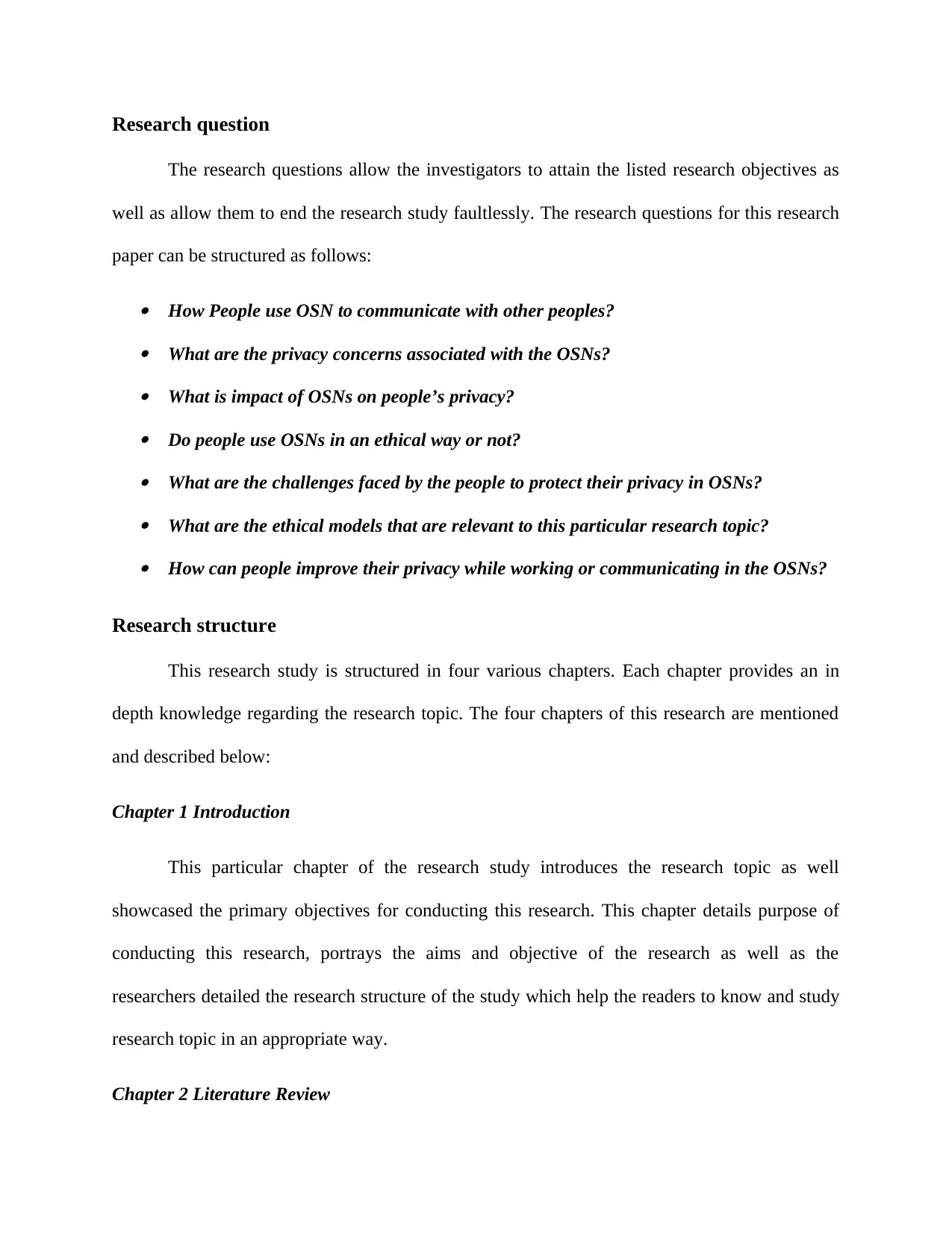
Research question
The research questions allow the investigators to attain the listed research objectives as
well as allow them to end the research study faultlessly. The research questions for this research
paper can be structured as follows:
How People use OSN to communicate with other peoples? What are the privacy concerns associated with the OSNs? What is impact of OSNs on people’s privacy? Do people use OSNs in an ethical way or not? What are the challenges faced by the people to protect their privacy in OSNs? What are the ethical models that are relevant to this particular research topic? How can people improve their privacy while working or communicating in the OSNs?
Research structure
This research study is structured in four various chapters. Each chapter provides an in
depth knowledge regarding the research topic. The four chapters of this research are mentioned
and described below:
Chapter 1 Introduction
This particular chapter of the research study introduces the research topic as well
showcased the primary objectives for conducting this research. This chapter details purpose of
conducting this research, portrays the aims and objective of the research as well as the
researchers detailed the research structure of the study which help the readers to know and study
research topic in an appropriate way.
Chapter 2 Literature Review
The research questions allow the investigators to attain the listed research objectives as
well as allow them to end the research study faultlessly. The research questions for this research
paper can be structured as follows:
How People use OSN to communicate with other peoples? What are the privacy concerns associated with the OSNs? What is impact of OSNs on people’s privacy? Do people use OSNs in an ethical way or not? What are the challenges faced by the people to protect their privacy in OSNs? What are the ethical models that are relevant to this particular research topic? How can people improve their privacy while working or communicating in the OSNs?
Research structure
This research study is structured in four various chapters. Each chapter provides an in
depth knowledge regarding the research topic. The four chapters of this research are mentioned
and described below:
Chapter 1 Introduction
This particular chapter of the research study introduces the research topic as well
showcased the primary objectives for conducting this research. This chapter details purpose of
conducting this research, portrays the aims and objective of the research as well as the
researchers detailed the research structure of the study which help the readers to know and study
research topic in an appropriate way.
Chapter 2 Literature Review
⊘ This is a preview!⊘
Do you want full access?
Subscribe today to unlock all pages.

Trusted by 1+ million students worldwide
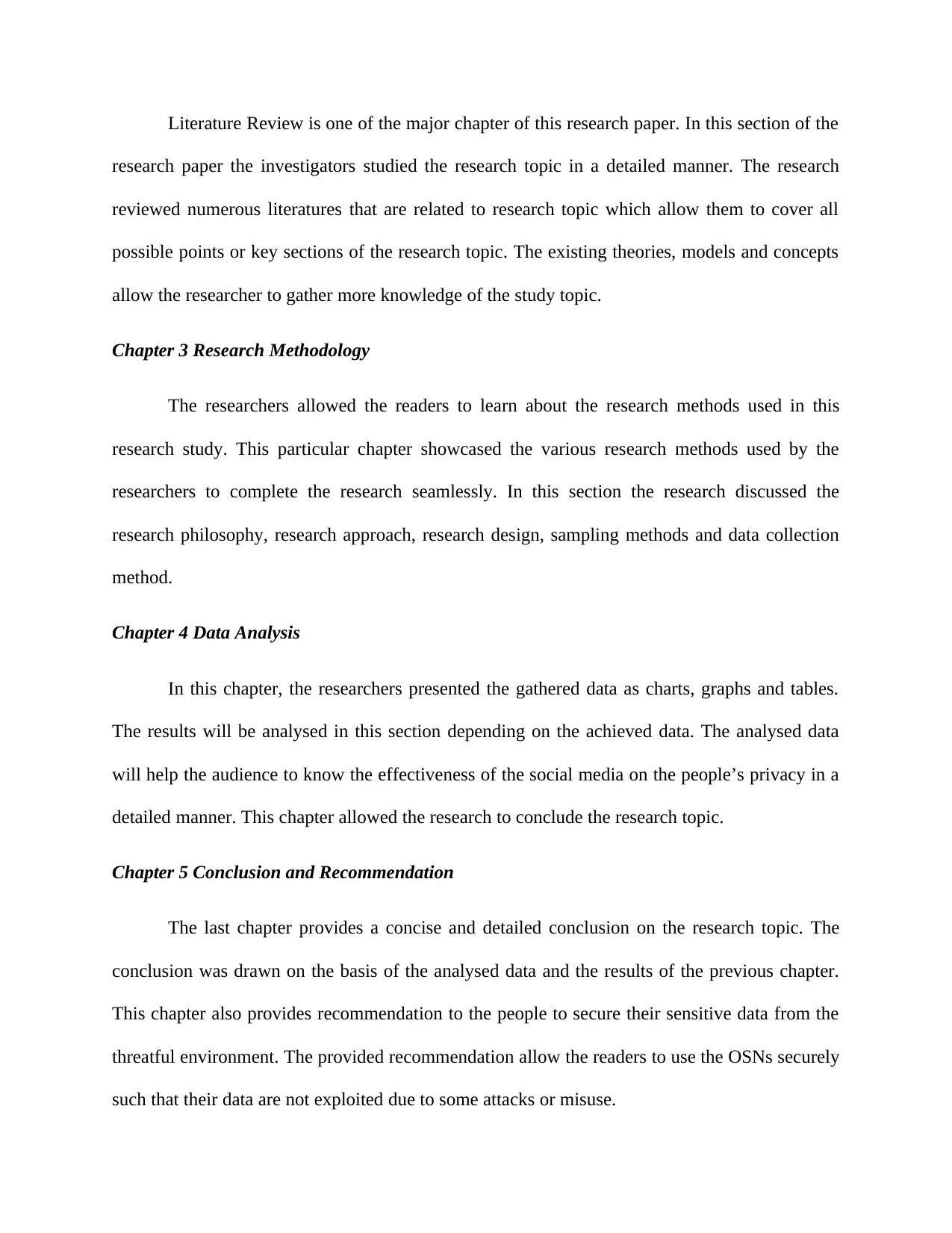
Literature Review is one of the major chapter of this research paper. In this section of the
research paper the investigators studied the research topic in a detailed manner. The research
reviewed numerous literatures that are related to research topic which allow them to cover all
possible points or key sections of the research topic. The existing theories, models and concepts
allow the researcher to gather more knowledge of the study topic.
Chapter 3 Research Methodology
The researchers allowed the readers to learn about the research methods used in this
research study. This particular chapter showcased the various research methods used by the
researchers to complete the research seamlessly. In this section the research discussed the
research philosophy, research approach, research design, sampling methods and data collection
method.
Chapter 4 Data Analysis
In this chapter, the researchers presented the gathered data as charts, graphs and tables.
The results will be analysed in this section depending on the achieved data. The analysed data
will help the audience to know the effectiveness of the social media on the people’s privacy in a
detailed manner. This chapter allowed the research to conclude the research topic.
Chapter 5 Conclusion and Recommendation
The last chapter provides a concise and detailed conclusion on the research topic. The
conclusion was drawn on the basis of the analysed data and the results of the previous chapter.
This chapter also provides recommendation to the people to secure their sensitive data from the
threatful environment. The provided recommendation allow the readers to use the OSNs securely
such that their data are not exploited due to some attacks or misuse.
research paper the investigators studied the research topic in a detailed manner. The research
reviewed numerous literatures that are related to research topic which allow them to cover all
possible points or key sections of the research topic. The existing theories, models and concepts
allow the researcher to gather more knowledge of the study topic.
Chapter 3 Research Methodology
The researchers allowed the readers to learn about the research methods used in this
research study. This particular chapter showcased the various research methods used by the
researchers to complete the research seamlessly. In this section the research discussed the
research philosophy, research approach, research design, sampling methods and data collection
method.
Chapter 4 Data Analysis
In this chapter, the researchers presented the gathered data as charts, graphs and tables.
The results will be analysed in this section depending on the achieved data. The analysed data
will help the audience to know the effectiveness of the social media on the people’s privacy in a
detailed manner. This chapter allowed the research to conclude the research topic.
Chapter 5 Conclusion and Recommendation
The last chapter provides a concise and detailed conclusion on the research topic. The
conclusion was drawn on the basis of the analysed data and the results of the previous chapter.
This chapter also provides recommendation to the people to secure their sensitive data from the
threatful environment. The provided recommendation allow the readers to use the OSNs securely
such that their data are not exploited due to some attacks or misuse.
Paraphrase This Document
Need a fresh take? Get an instant paraphrase of this document with our AI Paraphraser

Chapter 2: Literature Review
Social media concept
According to Fuchs 2017, social media are the computer-mediated digital platforms that
promote knowledge, thoughts, ideas, career interests and some other forms of expression across
virtual networks as well as communities to be produced or exchanged. Social media is
the network of online communication networks devoted to feedback, interaction information
exchange and collaboration centered on the culture. Among the various types of social media are
blogs and apps devoted to forums, social networking, microblogging, social curation, content
bookmarking and wikis. According to Lewis 2015, the users generally connect social media
services on computers and laptops through web-based technology, or download
the applications that provide social media capabilities on the mobile devices, such as tablets and
smart phones. When consumers communicate with the electronic resources, they build highly
interactive channels that allow individuals, groups, and organizations to exchange, co-create,
debate, contribute, and change publicly shared self-curated content or user-generated content
(Madden et al. 2013). The range of currently available stand-alone and the incorporated social
media services pose interpretation the challenges; however, some common features there are:
Social media are the Internet-based Web 2.0 applications that are interactive.
The lifeblood of the social media is user-generated content including comments or any
text post, digital images or videos, and data generated through all online interactions.
Users create network-specific website or device accounts and personalities that are built
and managed by the agency of social media.
Social media promotes the development of social networks online by linking the identity
of a person with that of other groups or individuals.
Social media concept
According to Fuchs 2017, social media are the computer-mediated digital platforms that
promote knowledge, thoughts, ideas, career interests and some other forms of expression across
virtual networks as well as communities to be produced or exchanged. Social media is
the network of online communication networks devoted to feedback, interaction information
exchange and collaboration centered on the culture. Among the various types of social media are
blogs and apps devoted to forums, social networking, microblogging, social curation, content
bookmarking and wikis. According to Lewis 2015, the users generally connect social media
services on computers and laptops through web-based technology, or download
the applications that provide social media capabilities on the mobile devices, such as tablets and
smart phones. When consumers communicate with the electronic resources, they build highly
interactive channels that allow individuals, groups, and organizations to exchange, co-create,
debate, contribute, and change publicly shared self-curated content or user-generated content
(Madden et al. 2013). The range of currently available stand-alone and the incorporated social
media services pose interpretation the challenges; however, some common features there are:
Social media are the Internet-based Web 2.0 applications that are interactive.
The lifeblood of the social media is user-generated content including comments or any
text post, digital images or videos, and data generated through all online interactions.
Users create network-specific website or device accounts and personalities that are built
and managed by the agency of social media.
Social media promotes the development of social networks online by linking the identity
of a person with that of other groups or individuals.
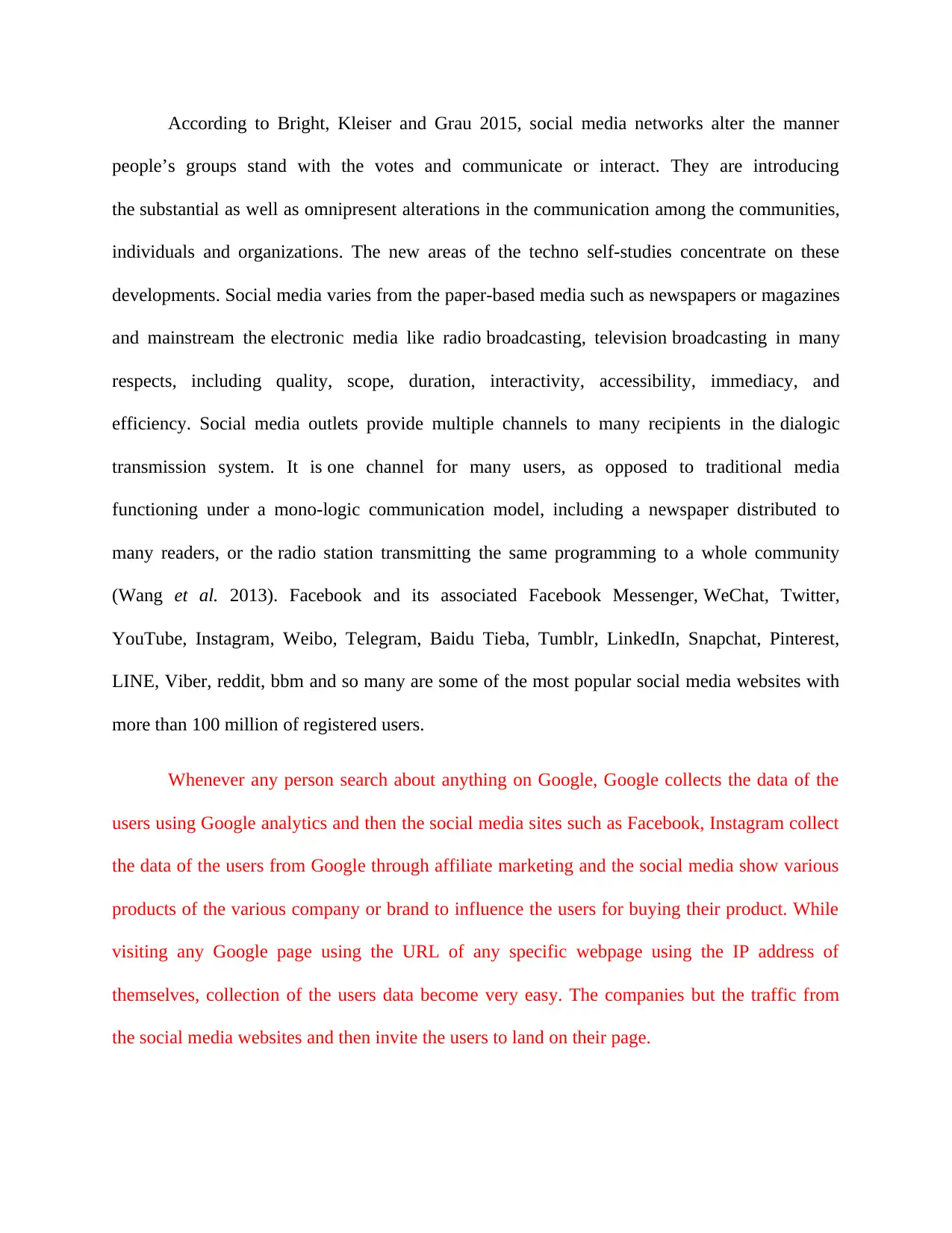
According to Bright, Kleiser and Grau 2015, social media networks alter the manner
people’s groups stand with the votes and communicate or interact. They are introducing
the substantial as well as omnipresent alterations in the communication among the communities,
individuals and organizations. The new areas of the techno self-studies concentrate on these
developments. Social media varies from the paper-based media such as newspapers or magazines
and mainstream the electronic media like radio broadcasting, television broadcasting in many
respects, including quality, scope, duration, interactivity, accessibility, immediacy, and
efficiency. Social media outlets provide multiple channels to many recipients in the dialogic
transmission system. It is one channel for many users, as opposed to traditional media
functioning under a mono-logic communication model, including a newspaper distributed to
many readers, or the radio station transmitting the same programming to a whole community
(Wang et al. 2013). Facebook and its associated Facebook Messenger, WeChat, Twitter,
YouTube, Instagram, Weibo, Telegram, Baidu Tieba, Tumblr, LinkedIn, Snapchat, Pinterest,
LINE, Viber, reddit, bbm and so many are some of the most popular social media websites with
more than 100 million of registered users.
Whenever any person search about anything on Google, Google collects the data of the
users using Google analytics and then the social media sites such as Facebook, Instagram collect
the data of the users from Google through affiliate marketing and the social media show various
products of the various company or brand to influence the users for buying their product. While
visiting any Google page using the URL of any specific webpage using the IP address of
themselves, collection of the users data become very easy. The companies but the traffic from
the social media websites and then invite the users to land on their page.
people’s groups stand with the votes and communicate or interact. They are introducing
the substantial as well as omnipresent alterations in the communication among the communities,
individuals and organizations. The new areas of the techno self-studies concentrate on these
developments. Social media varies from the paper-based media such as newspapers or magazines
and mainstream the electronic media like radio broadcasting, television broadcasting in many
respects, including quality, scope, duration, interactivity, accessibility, immediacy, and
efficiency. Social media outlets provide multiple channels to many recipients in the dialogic
transmission system. It is one channel for many users, as opposed to traditional media
functioning under a mono-logic communication model, including a newspaper distributed to
many readers, or the radio station transmitting the same programming to a whole community
(Wang et al. 2013). Facebook and its associated Facebook Messenger, WeChat, Twitter,
YouTube, Instagram, Weibo, Telegram, Baidu Tieba, Tumblr, LinkedIn, Snapchat, Pinterest,
LINE, Viber, reddit, bbm and so many are some of the most popular social media websites with
more than 100 million of registered users.
Whenever any person search about anything on Google, Google collects the data of the
users using Google analytics and then the social media sites such as Facebook, Instagram collect
the data of the users from Google through affiliate marketing and the social media show various
products of the various company or brand to influence the users for buying their product. While
visiting any Google page using the URL of any specific webpage using the IP address of
themselves, collection of the users data become very easy. The companies but the traffic from
the social media websites and then invite the users to land on their page.
⊘ This is a preview!⊘
Do you want full access?
Subscribe today to unlock all pages.

Trusted by 1+ million students worldwide

According to Stieglitz et al. 2014, the huge influx of the personal information made
available online and processed throughout the cloud has kept the user privacy at the center of
debate about the ability of the network to hold this personal information securely. The degree to
which consumers and operators on social media platforms may view user profiles are becoming
the new topic of the ethical consideration, and the regulation, knowledge and implications of
potential violations of the privacy remain crucial issues prior to technological age (Albarran
2013). Privacy advocates warn the social media users about their personal data collection. In the
research done by Westerman, Spence and Van Der Heide 2014, several information or data is
captured by the electronic tracking as well as the third-party applications without the consent or
knowledge of the users. Data could also be obtained by social media analysts utilizing data
mining methods for the law enforcement and the regulatory purposes. It is also possible to collect
the information and data for the use by third parties. When social media information is shared, it
is no longer private information. There are multiple cases where especially young people share
their personal information or data that may attract predators. According to Bucher and Helmond
2017, monitoring what is shared and knowing who could potentially share that data
or information with is very vital. In particular, teens now share substantially more data or
information on the social media site or internet than they have in their past. Teens share the
personal data or information, such as telephone number names of schools and email address
(Such and Criado 2016). Studies suggest that teenagers do not realize what they are sharing but
how much of those material third parties may reach.
According to Ruths and Pfeffer 2014, there are concerns that privacy is gone and that
some large social media users seem to have become very unconcerned about privacy as social
media expands more and more. Some argue though, that individuals are still very worried with
available online and processed throughout the cloud has kept the user privacy at the center of
debate about the ability of the network to hold this personal information securely. The degree to
which consumers and operators on social media platforms may view user profiles are becoming
the new topic of the ethical consideration, and the regulation, knowledge and implications of
potential violations of the privacy remain crucial issues prior to technological age (Albarran
2013). Privacy advocates warn the social media users about their personal data collection. In the
research done by Westerman, Spence and Van Der Heide 2014, several information or data is
captured by the electronic tracking as well as the third-party applications without the consent or
knowledge of the users. Data could also be obtained by social media analysts utilizing data
mining methods for the law enforcement and the regulatory purposes. It is also possible to collect
the information and data for the use by third parties. When social media information is shared, it
is no longer private information. There are multiple cases where especially young people share
their personal information or data that may attract predators. According to Bucher and Helmond
2017, monitoring what is shared and knowing who could potentially share that data
or information with is very vital. In particular, teens now share substantially more data or
information on the social media site or internet than they have in their past. Teens share the
personal data or information, such as telephone number names of schools and email address
(Such and Criado 2016). Studies suggest that teenagers do not realize what they are sharing but
how much of those material third parties may reach.
According to Ruths and Pfeffer 2014, there are concerns that privacy is gone and that
some large social media users seem to have become very unconcerned about privacy as social
media expands more and more. Some argue though, that individuals are still very worried with
Paraphrase This Document
Need a fresh take? Get an instant paraphrase of this document with our AI Paraphraser
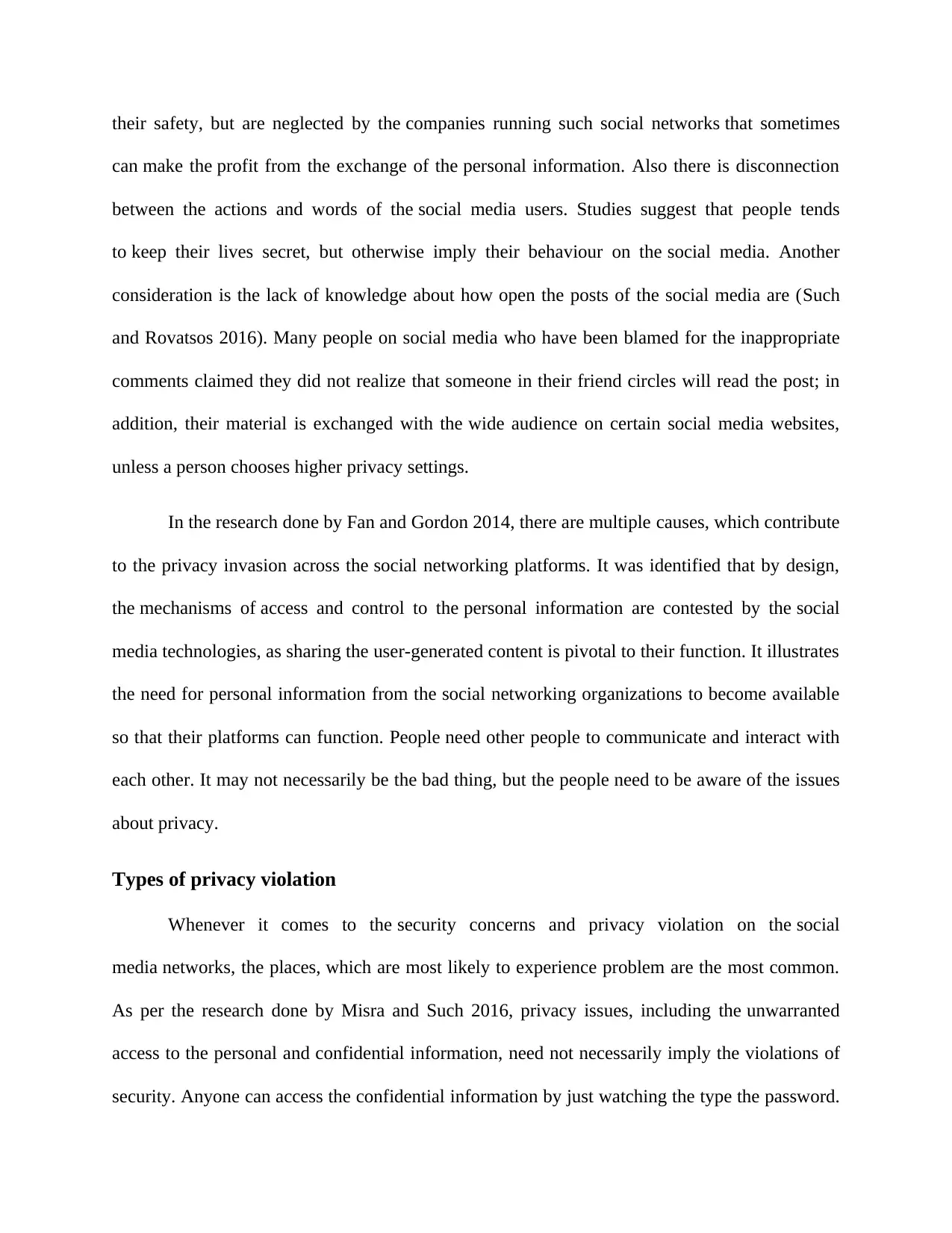
their safety, but are neglected by the companies running such social networks that sometimes
can make the profit from the exchange of the personal information. Also there is disconnection
between the actions and words of the social media users. Studies suggest that people tends
to keep their lives secret, but otherwise imply their behaviour on the social media. Another
consideration is the lack of knowledge about how open the posts of the social media are (Such
and Rovatsos 2016). Many people on social media who have been blamed for the inappropriate
comments claimed they did not realize that someone in their friend circles will read the post; in
addition, their material is exchanged with the wide audience on certain social media websites,
unless a person chooses higher privacy settings.
In the research done by Fan and Gordon 2014, there are multiple causes, which contribute
to the privacy invasion across the social networking platforms. It was identified that by design,
the mechanisms of access and control to the personal information are contested by the social
media technologies, as sharing the user-generated content is pivotal to their function. It illustrates
the need for personal information from the social networking organizations to become available
so that their platforms can function. People need other people to communicate and interact with
each other. It may not necessarily be the bad thing, but the people need to be aware of the issues
about privacy.
Types of privacy violation
Whenever it comes to the security concerns and privacy violation on the social
media networks, the places, which are most likely to experience problem are the most common.
As per the research done by Misra and Such 2016, privacy issues, including the unwarranted
access to the personal and confidential information, need not necessarily imply the violations of
security. Anyone can access the confidential information by just watching the type the password.
can make the profit from the exchange of the personal information. Also there is disconnection
between the actions and words of the social media users. Studies suggest that people tends
to keep their lives secret, but otherwise imply their behaviour on the social media. Another
consideration is the lack of knowledge about how open the posts of the social media are (Such
and Rovatsos 2016). Many people on social media who have been blamed for the inappropriate
comments claimed they did not realize that someone in their friend circles will read the post; in
addition, their material is exchanged with the wide audience on certain social media websites,
unless a person chooses higher privacy settings.
In the research done by Fan and Gordon 2014, there are multiple causes, which contribute
to the privacy invasion across the social networking platforms. It was identified that by design,
the mechanisms of access and control to the personal information are contested by the social
media technologies, as sharing the user-generated content is pivotal to their function. It illustrates
the need for personal information from the social networking organizations to become available
so that their platforms can function. People need other people to communicate and interact with
each other. It may not necessarily be the bad thing, but the people need to be aware of the issues
about privacy.
Types of privacy violation
Whenever it comes to the security concerns and privacy violation on the social
media networks, the places, which are most likely to experience problem are the most common.
As per the research done by Misra and Such 2016, privacy issues, including the unwarranted
access to the personal and confidential information, need not necessarily imply the violations of
security. Anyone can access the confidential information by just watching the type the password.
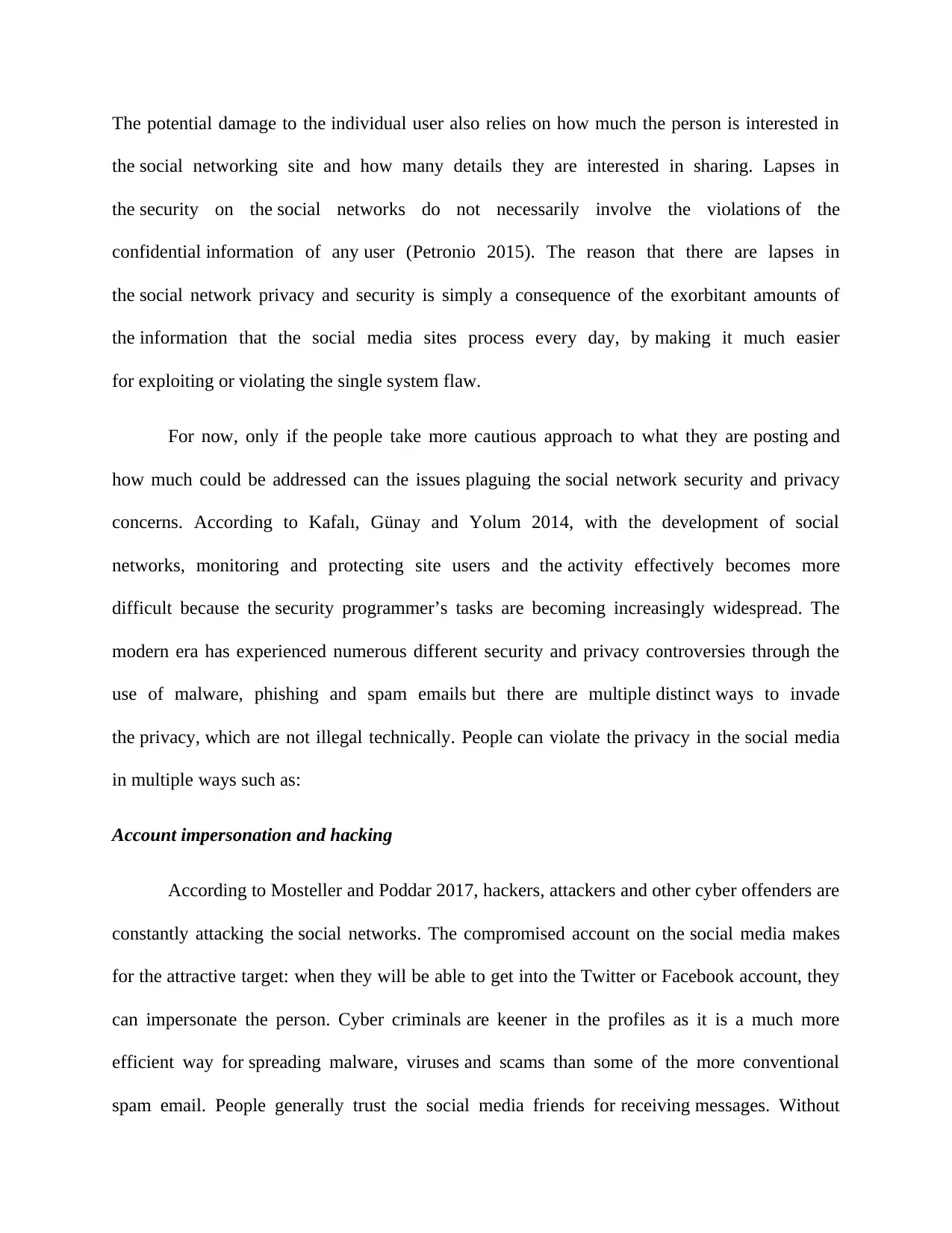
The potential damage to the individual user also relies on how much the person is interested in
the social networking site and how many details they are interested in sharing. Lapses in
the security on the social networks do not necessarily involve the violations of the
confidential information of any user (Petronio 2015). The reason that there are lapses in
the social network privacy and security is simply a consequence of the exorbitant amounts of
the information that the social media sites process every day, by making it much easier
for exploiting or violating the single system flaw.
For now, only if the people take more cautious approach to what they are posting and
how much could be addressed can the issues plaguing the social network security and privacy
concerns. According to Kafalı, Günay and Yolum 2014, with the development of social
networks, monitoring and protecting site users and the activity effectively becomes more
difficult because the security programmer’s tasks are becoming increasingly widespread. The
modern era has experienced numerous different security and privacy controversies through the
use of malware, phishing and spam emails but there are multiple distinct ways to invade
the privacy, which are not illegal technically. People can violate the privacy in the social media
in multiple ways such as:
Account impersonation and hacking
According to Mosteller and Poddar 2017, hackers, attackers and other cyber offenders are
constantly attacking the social networks. The compromised account on the social media makes
for the attractive target: when they will be able to get into the Twitter or Facebook account, they
can impersonate the person. Cyber criminals are keener in the profiles as it is a much more
efficient way for spreading malware, viruses and scams than some of the more conventional
spam email. People generally trust the social media friends for receiving messages. Without
the social networking site and how many details they are interested in sharing. Lapses in
the security on the social networks do not necessarily involve the violations of the
confidential information of any user (Petronio 2015). The reason that there are lapses in
the social network privacy and security is simply a consequence of the exorbitant amounts of
the information that the social media sites process every day, by making it much easier
for exploiting or violating the single system flaw.
For now, only if the people take more cautious approach to what they are posting and
how much could be addressed can the issues plaguing the social network security and privacy
concerns. According to Kafalı, Günay and Yolum 2014, with the development of social
networks, monitoring and protecting site users and the activity effectively becomes more
difficult because the security programmer’s tasks are becoming increasingly widespread. The
modern era has experienced numerous different security and privacy controversies through the
use of malware, phishing and spam emails but there are multiple distinct ways to invade
the privacy, which are not illegal technically. People can violate the privacy in the social media
in multiple ways such as:
Account impersonation and hacking
According to Mosteller and Poddar 2017, hackers, attackers and other cyber offenders are
constantly attacking the social networks. The compromised account on the social media makes
for the attractive target: when they will be able to get into the Twitter or Facebook account, they
can impersonate the person. Cyber criminals are keener in the profiles as it is a much more
efficient way for spreading malware, viruses and scams than some of the more conventional
spam email. People generally trust the social media friends for receiving messages. Without
⊘ This is a preview!⊘
Do you want full access?
Subscribe today to unlock all pages.

Trusted by 1+ million students worldwide
1 out of 40
Related Documents
Your All-in-One AI-Powered Toolkit for Academic Success.
+13062052269
info@desklib.com
Available 24*7 on WhatsApp / Email
![[object Object]](/_next/static/media/star-bottom.7253800d.svg)
Unlock your academic potential
Copyright © 2020–2025 A2Z Services. All Rights Reserved. Developed and managed by ZUCOL.





